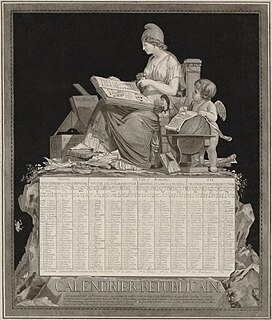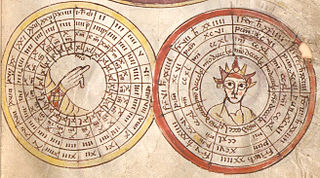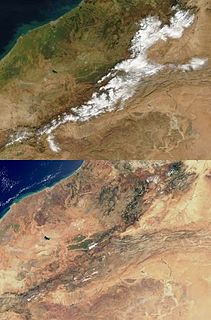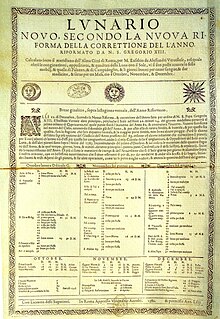Related Research Articles

A calendar is a system of organizing days. This is done by giving names to periods of time, typically days, weeks, months and years. A date is the designation of a single, specific day within such a system. A calendar is also a physical record of such a system. A calendar can also mean a list of planned events, such as a court calendar or a partly or fully chronological list of documents, such as a calendar of wills.

The French Republican calendar, also commonly called the French Revolutionary calendar, was a calendar created and implemented during the French Revolution, and used by the French government for about 12 years from late 1793 to 1805, and for 18 days by the Paris Commune in 1871. The revolutionary system was designed in part to remove all religious and royalist influences from the calendar, and was part of a larger attempt at decimalisation in France. It was used in government records in France and other areas under French rule, including Belgium, Luxembourg, and parts of the Netherlands, Germany, Switzerland, Malta, and Italy.
The Julian calendar, proposed by Julius Caesar in AUC 708, was a reform of the Roman calendar. It took effect on 1 January AUC 709 , by edict. It was designed with the aid of Greek mathematicians and astronomers such as Sosigenes of Alexandria.
A month is a unit of time, used with calendars, which is approximately as long as a natural period related to the motion of the Moon; month and Moon are cognates. The traditional concept arose with the cycle of Moon phases; such months (lunations) are synodic months and last approximately 29.53 days. From excavated tally sticks, researchers have deduced that people counted days in relation to the Moon's phases as early as the Paleolithic age. Synodic months, based on the Moon's orbital period with respect to the Earth-Sun line, are still the basis of many calendars today, and are used to divide the year.

A week is a time unit equal to seven days. It is the standard time period used for cycles of rest days in most parts of the world, mostly alongside—although not strictly part of—the Gregorian calendar.

New Year's Day, also simply called New Year or New Year's, is observed on 1 January, the first day of the year on the modern Gregorian calendar as well as the Julian calendar. Whilst most solar calendars begin the year regularly at or near the northern winter solstice, the start of the new year in cultures that observe a lunisolar or lunar calendar happen at less fixed points relative to the solar year.
Calendar reform or calendrical reform is any significant revision of a calendar system. The term sometimes is used instead for a proposal to switch to a different calendar design.
The traditional Korean calendar or Dangun calendar is a lunisolar calendar. Like most traditional calendars of other East Asian countries, the Korean Calendar is mainly derived from the Chinese calendar. Dates are calculated from Korea's meridian, and observances and festivals are based in Korean culture.
A calendar era is the period of time elapsed since one epoch of a calendar and, if it exists, before the next one. For example, the Gregorian calendar numbers its years in the Western Christian era.
The Irish calendar is the Gregorian calendar as it is in use in Ireland, but also incorporating Irish cultural festivals and views of the division of the seasons, presumably inherited from earlier Celtic calendar traditions.
The Hijri year or era is the era used in the Islamic lunar calendar, which begins its count from the Islamic New Year in 622 CE. During that year, Muhammad and his followers migrated from Mecca to Yathrib. This event, known as the Hijra, is commemorated in Islam for its role in the founding of the first Muslim community (ummah).
The Javanese calendar is the calendar of the Javanese people. It is used concurrently with two other calendars, the Gregorian calendar and the Islamic calendar. The Gregorian calendar is the official calendar of the Republic of Indonesia and civil society, while the Islamic calendar is used by Muslims and the Indonesian government for religious worship and deciding relevant Islamic holidays.
The Lithuanian calendar is unusual among Western countries in that neither the names of the months nor the names of the weekdays are derived from Greek or Norse mythology. They were formalized after Lithuania regained independence in 1918, based on historic names, and celebrate natural phenomena; three months are named for birds, two for trees, and the remainder for seasonal activities and features. The days of the week are simply ordinal numbers.

The Berber calendar is the agricultural calendar traditionally used by Berbers. It is also known as the fellaḥi. The calendar is utilized to regulate the seasonal agricultural works.
The Arabic names of the months of the Gregorian calendar are usually phonetic Arabic pronunciations of the corresponding month names used in European languages. An exception is the Syriac calendar used in Mesopotamia and the Levant, whose month names are inherited via Classical Arabic from the Babylonian and Hebrew lunisolar calendars and correspond to roughly the same time of year.
The Gregorian calendar is the calendar used in most of the world. It was introduced in October 1582 by Pope Gregory XIII as a minor modification of the Julian calendar, reducing the average year from 365.25 days to 365.2425 days, and adjusting for the drift in the 'tropical' or 'solar' year that the inaccuracy had caused during the intervening centuries.
A name in Romanian tradition consists of a given name (prenume) and a family name (surname). In official documents, surnames usually appear before given names.
While many Slavic languages officially use Latin-derived names for the months of the year in the Gregorian calendar, there is also a set of older names for the twelve months that differs from the Latin month names, as they are of Slavic origin. In some languages, such as the Serbian language these traditional names have since been archaized and are thus seldom used.

The adoption of the Gregorian Calendar was an event in the modern history of most cultures and societies, marking a change from their traditional dating system to the modern dating system that is widely used around the world today. Some states adopted the new calendar from 1582, some did not do so before the early twentieth century, and others did so at various dates between; however a number continue to use a different civil calendar. For many the new style calendar is only used for civil purposes and the old style calendar remains used in religious contexts. Today, the Gregorian calendar is the world's most widely used civil calendar. During – and for some time after – the change between systems, it has been common to use the terms Old Style and New Style when giving dates, to indicate which calendar was used to reckon them.
In Slavic Native Faith (Rodnovery) there are a number of shared holidays throughout the year, when important ritual activities are set according to shared calendars. Generally speaking, ritual activities may be distinguished into "external" (exoteric) and "internal" (esoteric) relatively to the different communities. External ceremonies are mass gatherings, usually held on important holidays dedicated to the worship of common gods, and involving large numbers of people. Internal ceremonies are those restricted to specific groups, and holding special meaning for such groups; they may comprise private rituals and worship of specific ancestors.
References
- Dicționarul explicativ al limbii române , Academia Română, Institutul de Lingvistică "Iorgu Iordan", Editura Univers Enciclopedic, 1998